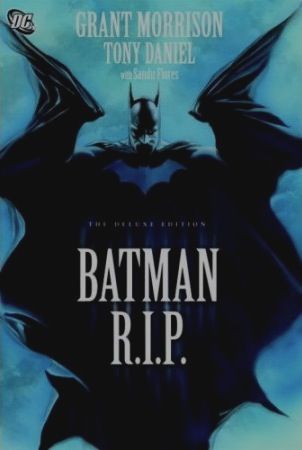In retrospect, much of the charm of the "Batman R.I.P." storyline rested in the anticipation of each serialized issue. The mystery of the Black Glove, and the theories about Dr. Hurt's true identity, fueled internet speculation and gave Grant Morrison's "Batman" run an expansive reach that far exceeded its actual page count. Now that DC has released a hardcover collection of Morrison's final arc (for now, at least, with the two-part "Final Crisis" tie-in included here as well), it's time to take a look at "R.I.P." as a story removed from its monthly (or pseudo-monthly) context. Does "Batman R.I.P." and its epilogue stand as an instant classic? Does this oversized "Deluxe Edition" hardcover accentuate the story's virtues? Is this book worth reading?
No. No. And yes, definitely.
"Batman R.I.P" and the "Last Rites" epilogue don't warrant "instant classic" status, especially cut off from their context and placed between two hard covers. And though the paper quality is excellent, the copy of the so-called "Deluxe Edition" that I read has some less-than perfect reproduction, at least on a few pages. It's not really noticeable in the artwork, but sometimes the lettering is slightly blurry, and you'll go from one perfectly sharp page to one that's just slightly off. It might be a printing problem with this slick paper, perhaps, but it makes for a distracting reading experience at times. And while a larger size might be nice, in theory (and I love the Absolute Editions and other oversized formats), Tony Daniel's artwork looks even more egregiously flawed when it's enlarged. Daniel does some decent work at times in the book, but more than a handful of the pages in "Batman R.I.P." are awkwardly rendered and dramatically weak. The bigger size only amplifies Daniel's inconsistencies.
But this is still a book worth reading, largely because what it loses in internet-speculation context, it gains in distance from Morrison's own promises. Many readers were annoyed, even angry, by the lack of clear resolution in the final chapter of "R.I.P." Here, in this isolated, hardcover context, the final chapter works much better. It's still not a conclusive finale to the larger question of Dr. Hurt's identity, but such a conclusion isn't promised within the book's pages. What's promised within its pages, implicitly, is a resolution to the Batman-gets-broken-mentally storyline. And that does, indeed, resolve, with a mentally-shattered Batman rising up from his own staged death -- as he literally smashes out of his own coffin -- and turning the tables on his enemies. It's a good Batman story, with betrayals and counter-betrayals, with a bravura performance from the Joker, and with enough unique visual concepts (the garish Zur-En-Arrh costume, Bat-Mite, the Club of Villains) to make the story rise well above the fair-to-middling morass of Batman collected editions.
The "Last Rites" two-parter provides a nice capstone to the book, celebrating Batman's life while deftly weaving in fragments of various incarnations of the character. The dream logic of the story works to its advantage -- it's the only way, really, to make sense out of the various retellings of the same basic adventures. And after the deconstruction of Batman's universe at the hands of the Black Glove (and Morrison himself), it's a fitting opportunity to rebuild the character using the narrative blocks of the past.
The book ends with a brief sketchbook section, and Daniel's art looks no better on those pages. A few of Morrison's thumbnail layouts are provided, and it's interesting to see how faithfully Daniel followed the writer's suggestions, but faithfulness of layout doesn't make for a better reading experience when the rendering and figure drawing work is as problematic as it is here. Lee Garbett's art on "Last Rites" isn't the best work he's done, but it has a solidity that Daniel rarely achieves inside these pages.
"Batman R.I.P.: The Deluxe Edition" may have its flaws, but it has its charms as well, and the manic, cagey story Morrison tells is certainly worth your attention.

